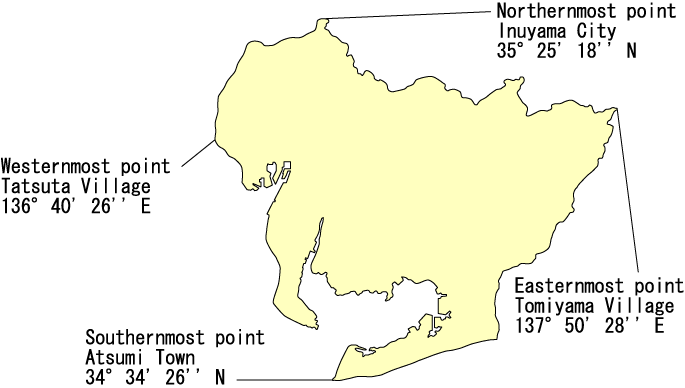|
 General
Introduction To Aichi Prefecture General
Introduction To Aichi Prefecture |
|
Position

Topography and climate
Aichi prefecture is located in central Japan facing the Pacific Ocean, resulting in attractive natural features
such as the Ise bay and the Mikawa gulf. The prefecture has four adjacent neighbors: Mie prefecture, Nagano prefecture,
Shizuoka prefecture and Gifu prefecture. The measured dimensions are from the Eastern border to the Western border:
106km, from the Southern border to the Northern border: 94km. Coming at the 28th rank for its land surface, Aichi
covers a total of 5,154 km2, thus having 1.4% of the country's total land mass.
In the Western part, the Kiso river, second largest river in the country, is located in the Noubi plain. To the
East, forming the Chita peninsula, the hilly Owari region spreads until the Pacific Ocean. Reaching as far as the
Yahagi river, the Mikawa highlands are situated North of the vast Okazaki plain. In the Eastern part, the Shitara
highlands and the Yana/Yumihari highlands on the upper side as well as the Toyohasi plain which extends until it
reaches the Toyokawa river. Finally, the Toyohashi plain adjoins the Atsumi peninsula.
The Pacific stream favors a generally mild climate in this part of the country. However, compared with the neighboring
cities of Okazaki and Toyohashi, the summer heat in Nagoya is remarkably severe. The annual rain precipitations
are more abundant closer to the mountains than in the plain or the peninsula. |
History
 |
The region used to be formed by three distinct independent countries, namely Owari, Mikawa and Ho. But after the
reform of Taika, were united Owari and Ho in a single entity until the advent of the Edo era.
In 1871, after t
he Haihanchiken (replacement of feudal countries by govermental prefectures) policy, Owari (except the Chita area)
formally became the great Nagoya prefecture, while Mikawa and Chita became the Nukata prefecture. In April 1872,
the Nagoya prefecture was renamed as Aichi prefecture, and on November 27 the Nukata prefecture was merged into
Aichi prefecture. Thus was born present Aichi prefecture, which is a united prefecture of historic Owari and Mikawa
countries.
In 1889 the concept of city, town and village subdivision was introduced and in 1891 the county subdivision came
into existence, resulting in the establishment of one central city and 19 counites. But in 1926 the county offices
were closed and replaced by the Aichi prefecture office. Following the new law to promote the merger of regional
subdivision, in the period from 1953 to 1956, series of merger took place to turn 13 cities and 204 villages into
21 cities and 90 villages. Since October 1, 1994, a new modern division of 31 cities, 47 towns and 10 villages
has been adopted. |
The origins of the name of Aichi
| The name of Aichi originated in the mind of a gifted poet named Takechi Kuroto, who composed the following poem
written in Manyoshu Volume III. It says, "A caw of crane leaves an echo in the field of Ayuchigata; I wonder
if the crane came to pick up fish in the tideland. "In his poem, Kuroto sang about a place known as Ayuchi
and afterwards the pronounciation became Aichi for practical reasons, which was adopted as the name of the county.
At the execution of Haihanchiken policy, prefecture office was established at Nagoya castle, which was located
at the center of Aichi county, so the name of Aichi was officially adopted. |

|